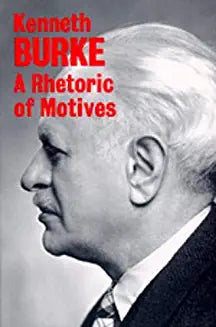A Rhetoric Of Motives
A Rhetoric Of Motives
Preço normal
€32,19 EUR
Preço normal
Preço de saldo
€32,19 EUR
Preço unitário
por
Imposto incluído.
Envio calculado na finalização da compra.
Não foi possível carregar a disponibilidade de recolha
Titulo: A Rhetoric Of Motives
Autor: Kenneth Burke
ESTADO: NOVO
ISBN/EAN: 9780520015463
Editor: University of California Press
Ano: 1969
Idioma: Inglês
Encadernação: N.A.
Páginas: 356
Coleção: N.A.
Nº. da Coleção: N.A.
Código de Controlo: 57C
Descrição: As critic, Kenneth Burke's preoccupations were at the beginning purely aesthetic and literary; but after "Counter-Statement" (1931), he began to discriminate a 'rhetorical' or persuasive component in literature, and thereupon became a philosopher of language and human conduct. In "A Grammar of Motives" (1945) and "A Rhetoric of Motives" (1950), Burke's conception of 'symbolic action' comes into its own: all human activities - linguistic or extra-linguistic - are modes of symbolizing; man is defined as the symbol-using (and -misusing) animal. The critic's job becomes one of the interpreting human symbolizing wherever he finds it, with the aim of illuminating human motivation. Thus the reach of the literary critic now extends to the social and ethical. "A Grammar of Motives" is a 'methodical meditation' on such complex linguistic forms as plays, stories, poems, theologies, metaphysical systems, political philosophies, and constitutions. "A Rhetoric of Motives" expands the field to human ways of persuasion and identification.
Ver detalhes completos
Autor: Kenneth Burke
ESTADO: NOVO
ISBN/EAN: 9780520015463
Editor: University of California Press
Ano: 1969
Idioma: Inglês
Encadernação: N.A.
Páginas: 356
Coleção: N.A.
Nº. da Coleção: N.A.
Código de Controlo: 57C
Descrição: As critic, Kenneth Burke's preoccupations were at the beginning purely aesthetic and literary; but after "Counter-Statement" (1931), he began to discriminate a 'rhetorical' or persuasive component in literature, and thereupon became a philosopher of language and human conduct. In "A Grammar of Motives" (1945) and "A Rhetoric of Motives" (1950), Burke's conception of 'symbolic action' comes into its own: all human activities - linguistic or extra-linguistic - are modes of symbolizing; man is defined as the symbol-using (and -misusing) animal. The critic's job becomes one of the interpreting human symbolizing wherever he finds it, with the aim of illuminating human motivation. Thus the reach of the literary critic now extends to the social and ethical. "A Grammar of Motives" is a 'methodical meditation' on such complex linguistic forms as plays, stories, poems, theologies, metaphysical systems, political philosophies, and constitutions. "A Rhetoric of Motives" expands the field to human ways of persuasion and identification.


